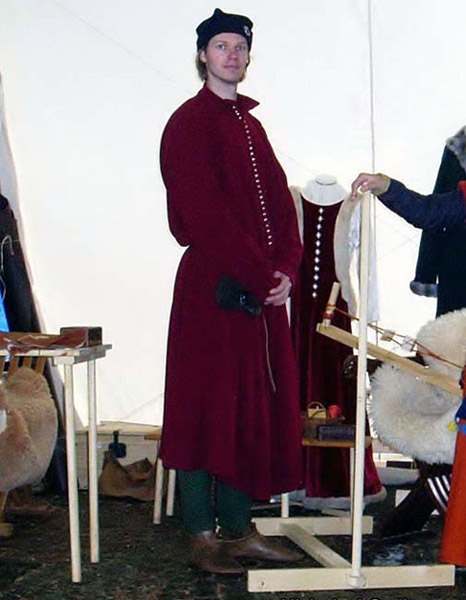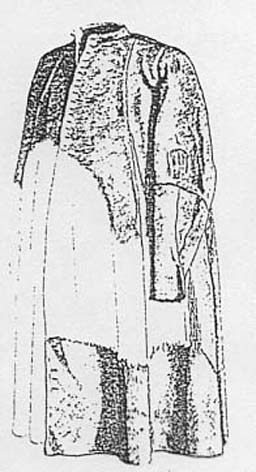
14th Century Herjolfnes Coat, Find #63
Description
Herjolfnes coat in high quality red wool, with pewter buttons made by my husband. All visible seams and buttons holes are hand sewn. White linen undershirt and long legged braies, green woollen hosen, brown leather turnshoes, belt and purse and a blue woollen shallow square hat.
Inspiration

The original owned by the Nationalmuseet Copenhagen.
Source of image:
http://historiskdrakt.wordpress.com/


Reconstruction drawings made by Norlund.

A young boy in a long buttoned gown, painted around 1380.
Source: detail of Altichieros painting, from Sr.George's chapel in Padua, Italy.
Patterns used
A paper pattern, made directly from the original by the Teko-Center, is for sale at museum shop the Nationalmuseet Copenhagen, Denmark.
More information
The coat is made from 8 panels flaring outwards from the shoulders. It has a small upright collar and a buttonclosure center front.
This herjolfsnes gown or coat is very similar to the buttoned gown as was worn in Europe. The buttoned gown can be seen as the early version of the houppelande (houpelande) and can be found in contempary source from the mid fourteenth century. The herjolfsnes gown has been radiocarbon dated to AD1280-1400 (p. 253 1 ). In the paragraph about this garment(p. 1961) it is dated c.1350.
The big difference between a buttoned gown and this Herjolfsnes buttoned gown or coat is that the buttoned gown
was the outer-layer of a costume, beneath it a doublet and a shirt was worn. The herjolfsnes gown was most likely not
worn as the outer-layer. On page 1301 Østergård says about the herjolfsnes gown/coat:
The garment D 10594 has been described as a buttoning coat. This is due to a reading of the words 'kiutell
knappadhan'. But the term is a little misleading, since it is associated with outer clothing, and since none of these
buttoned garments is made from thick vadmal, we must assume that like all the other garments they are not for outdoor
use in a wet or cold climate.
Sources
- Woven into the earth,textiles from the norse greenland - Else Østergård
- The Medieval Tailor's Assistant - Sarah Thursfield



